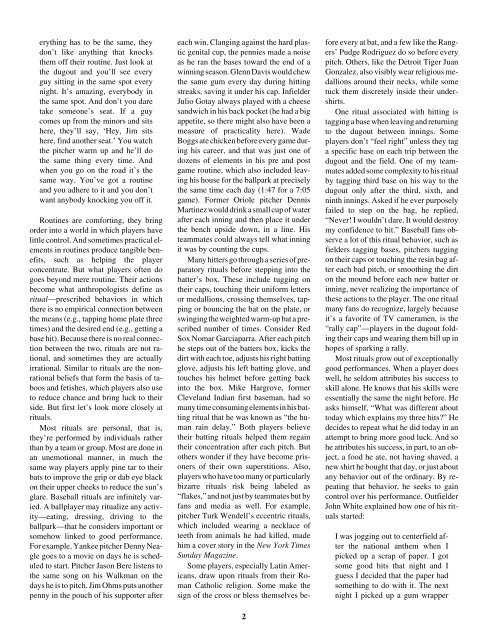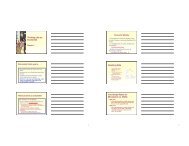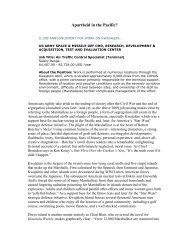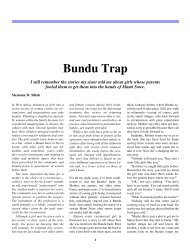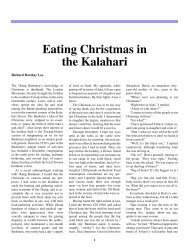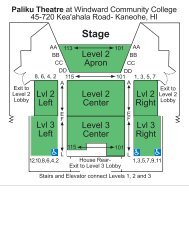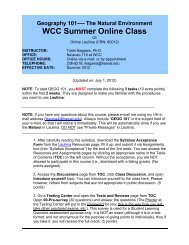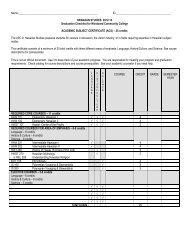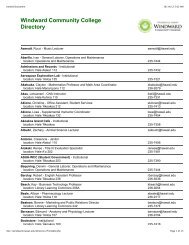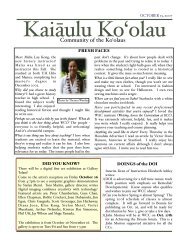Article 32 Baseball Magic - Windward Community College
Article 32 Baseball Magic - Windward Community College
Article 32 Baseball Magic - Windward Community College
Create successful ePaper yourself
Turn your PDF publications into a flip-book with our unique Google optimized e-Paper software.
ANNUAL EDITIONS<br />
erything has to be the same, they<br />
don’t like anything that knocks<br />
them off their routine. Just look at<br />
the dugout and you’ll see every<br />
guy sitting in the same spot every<br />
night. It’s amazing, everybody in<br />
the same spot. And don’t you dare<br />
take someone’s seat. If a guy<br />
comes up from the minors and sits<br />
here, they’ll say, ‘Hey, Jim sits<br />
here, find another seat.’ You watch<br />
the pitcher warm up and he’ll do<br />
the same thing every time. And<br />
when you go on the road it’s the<br />
same way. You’ve got a routine<br />
and you adhere to it and you don’t<br />
want anybody knocking you off it.<br />
Routines are comforting, they bring<br />
order into a world in which players have<br />
little control. And sometimes practical elements<br />
in routines produce tangible benefits,<br />
such as helping the player<br />
concentrate. But what players often do<br />
goes beyond mere routine. Their actions<br />
become what anthropologists define as<br />
ritual—prescribed behaviors in which<br />
there is no empirical connection between<br />
the means (e.g., tapping home plate three<br />
times) and the desired end (e.g., getting a<br />
base hit). Because there is no real connection<br />
between the two, rituals are not rational,<br />
and sometimes they are actually<br />
irrational. Similar to rituals are the nonrational<br />
beliefs that form the basis of taboos<br />
and fetishes, which players also use<br />
to reduce chance and bring luck to their<br />
side. But first let’s look more closely at<br />
rituals.<br />
Most rituals are personal, that is,<br />
they’re performed by individuals rather<br />
than by a team or group. Most are done in<br />
an unemotional manner, in much the<br />
same way players apply pine tar to their<br />
bats to improve the grip or dab eye black<br />
on their upper cheeks to reduce the sun’s<br />
glare. <strong>Baseball</strong> rituals are infinitely varied.<br />
A ballplayer may ritualize any activity—eating,<br />
dressing, driving to the<br />
ballpark—that he considers important or<br />
somehow linked to good performance.<br />
For example, Yankee pitcher Denny Neagle<br />
goes to a movie on days he is scheduled<br />
to start. Pitcher Jason Bere listens to<br />
the same song on his Walkman on the<br />
days he is to pitch. Jim Ohms puts another<br />
penny in the pouch of his supporter after<br />
each win. Clanging against the hard plastic<br />
genital cup, the pennies made a noise<br />
as he ran the bases toward the end of a<br />
winning season. Glenn Davis would chew<br />
the same gum every day during hitting<br />
streaks, saving it under his cap. Infielder<br />
Julio Gotay always played with a cheese<br />
sandwich in his back pocket (he had a big<br />
appetite, so there might also have been a<br />
measure of practicality here). Wade<br />
Boggs ate chicken before every game during<br />
his career, and that was just one of<br />
dozens of elements in his pre and post<br />
game routine, which also included leaving<br />
his house for the ballpark at precisely<br />
the same time each day (1:47 for a 7:05<br />
game). Former Oriole pitcher Dennis<br />
Martinez would drink a small cup of water<br />
after each inning and then place it under<br />
the bench upside down, in a line. His<br />
teammates could always tell what inning<br />
it was by counting the cups.<br />
Many hitters go through a series of preparatory<br />
rituals before stepping into the<br />
batter’s box. These include tugging on<br />
their caps, touching their uniform letters<br />
or medallions, crossing themselves, tapping<br />
or bouncing the bat on the plate, or<br />
swinging the weighted warm-up bat a prescribed<br />
number of times. Consider Red<br />
Sox Nomar Garciaparra. After each pitch<br />
he steps out of the batters box, kicks the<br />
dirt with each toe, adjusts his right batting<br />
glove, adjusts his left batting glove, and<br />
touches his helmet before getting back<br />
into the box. Mike Hargrove, former<br />
Cleveland Indian first baseman, had so<br />
many time consuming elements in his batting<br />
ritual that he was known as “the human<br />
rain delay.” Both players believe<br />
their batting rituals helped them regain<br />
their concentration after each pitch. But<br />
others wonder if they have become prisoners<br />
of their own superstitions. Also,<br />
players who have too many or particularly<br />
bizarre rituals risk being labeled as<br />
“flakes,” and not just by teammates but by<br />
fans and media as well. For example,<br />
pitcher Turk Wendell’s eccentric rituals,<br />
which included wearing a necklace of<br />
teeth from animals he had killed, made<br />
him a cover story in the New York Times<br />
Sunday Magazine.<br />
Some players, especially Latin Americans,<br />
draw upon rituals from their Roman<br />
Catholic religion. Some make the<br />
sign of the cross or bless themselves be-<br />
2<br />
fore every at bat, and a few like the Rangers’<br />
Pudge Rodriguez do so before every<br />
pitch. Others, like the Detroit Tiger Juan<br />
Gonzalez, also visibly wear religious medallions<br />
around their necks, while some<br />
tuck them discretely inside their undershirts.<br />
One ritual associated with hitting is<br />
tagging a base when leaving and returning<br />
to the dugout between innings. Some<br />
players don’t “feel right” unless they tag<br />
a specific base on each trip between the<br />
dugout and the field. One of my teammates<br />
added some complexity to his ritual<br />
by tagging third base on his way to the<br />
dugout only after the third, sixth, and<br />
ninth innings. Asked if he ever purposely<br />
failed to step on the bag, he replied,<br />
“Never! I wouldn’t dare. It would destroy<br />
my confidence to hit.” <strong>Baseball</strong> fans observe<br />
a lot of this ritual behavior, such as<br />
fielders tagging bases, pitchers tugging<br />
on their caps or touching the resin bag after<br />
each bad pitch, or smoothing the dirt<br />
on the mound before each new batter or<br />
inning, never realizing the importance of<br />
these actions to the player. The one ritual<br />
many fans do recognize, largely because<br />
it’s a favorite of TV cameramen, is the<br />
“rally cap”—players in the dugout folding<br />
their caps and wearing them bill up in<br />
hopes of sparking a rally.<br />
Most rituals grow out of exceptionally<br />
good performances. When a player does<br />
well, he seldom attributes his success to<br />
skill alone. He knows that his skills were<br />
essentially the same the night before. He<br />
asks himself, “What was different about<br />
today which explains my three hits?” He<br />
decides to repeat what he did today in an<br />
attempt to bring more good luck. And so<br />
he attributes his success, in part, to an object,<br />
a food he ate, not having shaved, a<br />
new shirt he bought that day, or just about<br />
any behavior out of the ordinary. By repeating<br />
that behavior, he seeks to gain<br />
control over his performance. Outfielder<br />
John White explained how one of his rituals<br />
started:<br />
I was jogging out to centerfield after<br />
the national anthem when I<br />
picked up a scrap of paper. I got<br />
some good hits that night and I<br />
guess I decided that the paper had<br />
something to do with it. The next<br />
night I picked up a gum wrapper


